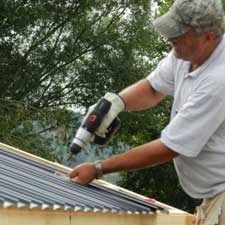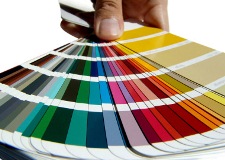My maternal great-grandparents purchased a cabin on Newman Lake, Washington from its original owner/builder in 1937. Nine years later, it was sold by them to their son and his wife – my grandparents Boyd and Jerene McDowell. A little over thirty years ago, I inherited this cabin from them. Having grown up spending most of my summers there, I envisioned turning this cabin into a year-around home.
This cabin’s original hand split cedar shake roofing (on a 7/12 slope over 1x skip sheeting) had been replaced once, by my father – and we enjoyed using these original shingles as fire starter for many years. This second roof was then again replaced with Cocoa Brown polyester painted thru-screwed steel. Polyester paint, while certainly a step up from bare galvanized, did not maintain its original luster for long (for extended reading on Polyester paint: https://www.hansenpolebuildings.com/2014/05/polyester-paint/).
As my vision involved significant remodel work, we opted to change roofing to a SMP paint (https://www.hansenpolebuildings.com/2014/05/smp/) with an actual fade and chalk warranty. Through a series of events, our remodel schedule had to be moved forward from its originally intended Spring start, to doing work in Winter. Again (keep in mind), in Northeast Washington. Of course, as luck would have it, reroofing coincided with bitter cold and snow showers – resulting in speed of installation becoming of utmost importance. While I did much work myself, I had an assist from a casual labor wrangler appropriately known as “Big Kevin” who would round up day labor as needed. This reroof required some of these extra bodies.
 Fast forwarding a few years, I found some steel roof thru-screws were “backing out”. Upon careful examination, I found out why – in a hurry to get roofing installed, Big Kevin’s casual help had decided it would be quicker to pound screws in with a hammer (as could be evidenced by damage to screw heads)!
Fast forwarding a few years, I found some steel roof thru-screws were “backing out”. Upon careful examination, I found out why – in a hurry to get roofing installed, Big Kevin’s casual help had decided it would be quicker to pound screws in with a hammer (as could be evidenced by damage to screw heads)!
When screws are either over driven (or beat in by hammer), it damages wood fibers reducing or virtually eliminating their holding power. There was a solution – replacing these #9 diameter screws with larger #14 screws. These larger diameter screws, installed properly, were then able to get a firm bite into undamaged wood.
Using an actual screw gun (rather than a drill motor) with a clutch prevents most instances of over driving screws. Should a screw inadvertently be over driven, there is a quick field fix. All it takes is a short 2×4 and a table saw. Cutting with grain of wood, make a series of cuts in both directions to leave 1/8” squares remaining when looking at the 2×4 end. Turning to cut cross grain, chop these off in one-inch increments. This results in what appears to now be headless match sticks (albeit from much stronger lumber). Remove any offending screws and carefully drive a 1/8” square by an inch ‘plug’ into the screw hole in the underlying purlin. A screw can then be replaced into a plug filled hole, where it will happily remain in place.
Tag Archives: polyester paint
This article, by my friend Sharon Thatcher, was originally published in the September 2016 issue of Rural Builder magazine and appears unedited. To continue from last Friday:
THE IMPORTANCE OF PAINT
While paint doesn’t provide any structural value, it certainly does add value to the end product. Unpainted panel still has a big audience, but painted coil is now more popular than ever and it’s what most customers see most clearly.
Dan Knight came up through the steel ranks via the paint industry and he explains the different types of paint.
There are three types of paint systems for metal that are commonly used here in the U.S.:
Polyesters: the least expensive, usually with a 10-year warranty on an exposed application.
“Polyesters are a very good workhorse but typically they don’t have the exterior durability that’s required on the warranted products,” Knight said. “So where you see them is on the low- or non-warranted systems such as interior liner panels, gutters, non-warranted or very low-warranted wall and roofing panels. There is always going to be a market need, some people call it shade-and-shelter. It’s located in the back 40 and it’s not expected to last 40 years.”
SMP (silicone polyesters): The most widely used, averaging a 40-year warranty on the film (but fade and chalk can occur over time).
“It’s basically a more durable exterior grade system. This is the workhorse in the rural builder’s market,” Knight explained. “This is commonly referred to as a 40-year paint system.”
PVDF (Polyvinylidene fluoride – trade names include Kynar and Hylar): the premium paint system, averaging a 25-year warranty, but with the best protection against fade and chalk.
“You see [PVDF] a lot in commercial buildings,” said Knight.
The thickness of the paint is important. The thicker the paint, the better the panel can weather the elements and protect the substrate.
For warranted material, the primer should be a minimum of .2 mils thick and the paint or topcoat at least .8 mils for a total of 1 mil thickness. Like steel, there is a range: for top primer the range is 0.2-0.3 mils; the top paint or coat is 0.7-0.8; and the bottom or backer with primer is 0.5-0.7 mils.
PAINT WARRANTY
“This is where understanding the supply chain of the paint system is important,” Knight said. “What you have to understand is that the paint warranty only covers three facets:
Chalk: This is a degradation of the resin and the pigments over time. When you rub your hand on the coating, it leaves a white residue.
Fade: the depth of color difference, say when a dark brown paint turns to a light brown.
Film integrity: the ability of the paint to stick to the metal.
“What is interesting, everybody says 40-year warranted paint but [with SMPs] the film integrity is 40 years, the chalk and the fade are 30 years,” Knight said.
The cause of this color variation was due to using mixed panels from two different paint systems. The fabricator was found to be at fault and left to correct the problem for the homeowner.
In the U.S., the paint warranty comes from the paint company (an Akzo Nobel, a Valspar, a Duracoat) and is held by the company that applies it. No paint warranties are transferable. The paint warranty remains with the fabricator.
When there is a problem, it goes up through the chain to evaluate the cause of the failure and who will take responsibility, including the installer.
All roll formers should have available their agreements with the paint company, with the important facets of that language written into their own agreements as a protection for themselves and their customers.
Confused yet? To builders Knight noted: “I think it’s important to deal with a reputable roll former who has the depth to stand behind their product.”
HANDLE WITH CARE
Once off the production line and on the job site, it’s up to the builder to make sure the panel is handled correctly. Don Switzer offers these job site tips.
Job site storage: “I know you think, well it’s building panels, we can store it outside,” he said, “but building panels are built to be on a building, not to be in a stack … In particular you don’t want water to get between the sheets so it causes the paint to delaminate. The pressure of the stack, and the water forces the water through the paint and makes it delaminate. Once they are on the building, and the water is hitting them, the water is just running off. But when you have the water trapped, that’s where you have a problem.”
Installation: “The key is that you don’t damage the surface,” he said. “The metallic coatings without paint (Galvalume or galvanized) or the metallic coatings with paint are not as hard as the steel substrates beneath those paints. So you want to make sure you don’t compromise the integrity of the painted or metallic surface. Again, once they’re up and they’re not scratched, you don’t have a problem. But if you scratch that product all the way down to the base metal, it’s going to rust because you’ve damaged the barrier placed there to protect it.”
MORE ON WARRANTIES
Stay tuned tomorrow, as I share “the rest of the story”…
Where the Idea of Colored Steel Siding and Roofing Started
Back in the Stone Ages, when I first entered the post frame (pole building) industry, factory pre-painted steel siding was still in a relative infancy. So much so as most steel roofs were yet still bare galvanized! It was a rarity to have a colored steel roof!
Colors were relatively limited (red, white, blue, green, gold, beige and brown) and the paint was not the greatest. Read about polyester paint here: https://www.hansenpolebuildings.com/2014/05/polyester-paint/), but they were colors and the world was overjoyed!!
But where did the idea of painted steel come from?
As the late, great Paul Harvey would have said, now here is …. the rest of the story….
Henry Getz began his career working at his father’s company, Interlocking Fence Company of Morton, Illinois. Interlocking Fence Company started as a mail-order farm supply company providing fencing and other items needed by farm families. The company later offered a Quonset-style building with a laminated arched rib covered with galvanized sheeting. Seeing the potential in another style of building, Getz began moving the company into post-frame construction.
From the start, Henry constantly sought the “something extra” to offer customers, and in the early 1950s he introduced one of his most important innovations: the addition of color to otherwise plain galvanized sheet-metal buildings.
Though he was told farmers would never pay more for color, Henry pressed ahead. The first color introduced was stained red and incorporated into the gable trim. Soon after, the company added the option of using colored trims for sliding doors, beginning with red trim and track.
As post-frame construction gained popularity, the Quonset-style building was discontinued, and Henry and Interlocking Fence Company began constructing the post-frame structures familiar today.
 Believing color was spurring the industry’s growth and offered an opportunity to expand into the commercial building market, Henry sought out builders interested in transitioning to a painted steel panel. The assembly of a like-minded group was part of an effort to decrease the cost for all involved parties. Although this effort was ultimately unsuccessful, Henry persevered and began offering painted steel panels himself. His advertising at the time strikingly compared a building without color on the roof to a mannequin without hair!
Believing color was spurring the industry’s growth and offered an opportunity to expand into the commercial building market, Henry sought out builders interested in transitioning to a painted steel panel. The assembly of a like-minded group was part of an effort to decrease the cost for all involved parties. Although this effort was ultimately unsuccessful, Henry persevered and began offering painted steel panels himself. His advertising at the time strikingly compared a building without color on the roof to a mannequin without hair!
Some astute readers may have made the connection between Henry Getz and Morton, IL. For those who didn’t – think “Morton Buildings” and you will have it!
When I consider the tens of thousands of building projects I have had the privilege of working on, I have to doff my hat to Henry Getz for the insight in starting what has become a beautiful palette of colors!






